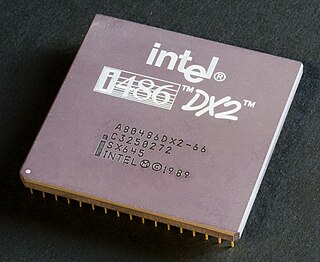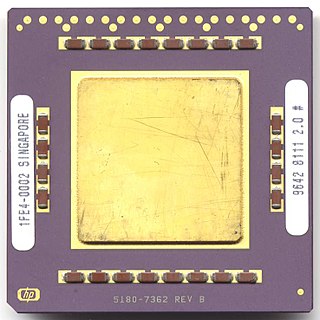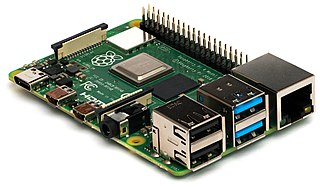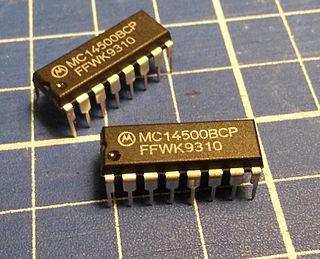
A central processing unit (CPU), also called a central processor, main processor or just processor, is the electronic circuitry within a computer that executes instructions that make up a computer program. The CPU performs basic arithmetic, logic, controlling, and input/output (I/O) operations specified by the instructions in the program. The computer industry used the term "central processing unit" as early as 1955. Traditionally, the term "CPU" refers to a processor, more specifically to its processing unit and control unit (CU), distinguishing these core elements of a computer from external components such as main memory and I/O circuitry.
The control unit (CU) is a component of a computer's central processing unit (CPU) that directs the operation of the processor. It tells the computer's memory, arithmetic and logic unit and input and output devices how to respond to the instructions that have been sent to the processor.

In computer architecture, a bus is a communication system that transfers data between components inside a computer, or between computers. This expression covers all related hardware components and software, including communication protocols.

The Intel 8080 ("eighty-eighty") is the second 8-bit microprocessor designed and manufactured by Intel. It first appeared in April 1974 and is an extended and enhanced variant of the earlier 8008 design, although without binary compatibility. The initial specified clock rate or frequency limit was 2 MHz, and with common instructions using 4, 5, 7, 10, or 11 cycles this meant that it operated at a typical speed of a few hundred thousand instructions per second. A faster variant 8080A-1 became available later with clock frequency limit up to 3.125 MHz.

The Motorola 68000 is a 16/32-bit complex instruction set computer (CISC) microprocessor, introduced in 1979 by Motorola Semiconductor Products Sector.

A minicomputer, or colloquially mini, is a class of smaller computers that was developed in the mid-1960s and sold for much less than mainframe and mid-size computers from IBM and its direct competitors. In a 1970 survey, The New York Times suggested a consensus definition of a minicomputer as a machine costing less than US$25,000, with an input-output device such as a teleprinter and at least four thousand words of memory, that is capable of running programs in a higher level language, such as Fortran or BASIC.

PA-RISC is an instruction set architecture (ISA) developed by Hewlett-Packard. As the name implies, it is a reduced instruction set computer (RISC) architecture, where the PA stands for Precision Architecture. The design is also referred to as HP/PA for Hewlett Packard Precision Architecture.

A microcomputer is a small, relatively inexpensive computer with a microprocessor as its central processing unit (CPU). It includes a microprocessor, memory and minimal input/output (I/O) circuitry mounted on a single printed circuit board (PCB). Microcomputers became popular in the 1970s and 1980s with the advent of increasingly powerful microprocessors. The predecessors to these computers, mainframes and minicomputers, were comparatively much larger and more expensive. Many microcomputers are also personal computers.
Very long instruction word (VLIW) refers to instruction set architectures designed to exploit instruction level parallelism (ILP). Whereas conventional central processing units mostly allow programs to specify instructions to execute in sequence only, a VLIW processor allows programs to explicitly specify instructions to execute in parallel. This design is intended to allow higher performance without the complexity inherent in some other designs.

The Intel 4040 microprocessor was the successor to the Intel 4004. It was introduced in 1974. The 4040 employed a 10 μm silicon gate enhancement load PMOS technology, was made up of 3,000 transistors and could execute approximately 62,000 instructions per second. General performance, bus layout and instruction set was identical to the 4004, with the main improvements being in the addition of extra lines and instructions to recognise and service interrupts and hardware Halt/Stop commands, an extended internal stack and general-purpose "Index" register space to handle nesting of several subroutines and/or interrupts, plus a doubling of program ROM address range.

The HP 48 is a series of graphing calculators using Reverse Polish Notation (RPN) and the RPL programming language, designed and produced by Hewlett-Packard from 1990 until 2003. The series includes the HP 48S, HP 48SX, HP 48G, HP 48GX, and HP 48G+, the G models being expanded and improved versions of the S models. The models with an X suffix are expandable via special RAM and ROM cards. In particular, the GX models have more onboard memory than the G models. The G+ models have more onboard memory only. The SX and S models have the same amount of onboard memory.
Memory-mapped I/O (MMIO) and port-mapped I/O (PMIO) are two complementary methods of performing input/output (I/O) between the central processing unit (CPU) and peripheral devices in a computer. An alternative approach is using dedicated I/O processors, commonly known as channels on mainframe computers, which execute their own instructions.
In computer architecture, 4-bit integers, memory addresses, or other data units are those that are 4 bits wide. Also, 4-bit CPU and ALU architectures are those that are based on registers, address buses, or data buses of that size. A group of four bits is also called a nibble and has 24 = 16 possible values.

The HP 2100 is a series of 16-bit minicomputers that were produced by Hewlett-Packard (HP) from the mid-1960s to early 1990s. Tens of thousands of machines in the series were sold over its twenty-five year lifetime, making HP the fourth largest minicomputer vendor during the 1970s.
The HP 3000 series is a family of minicomputers from Hewlett-Packard. It was designed to be the first minicomputer with full support for time-sharing in the hardware and the operating system, features that had mostly been limited to mainframes, or retrofitted to existing systems like Digital's PDP-11, on which Unix was implemented. First introduced in 1972, the last models reached end-of-life in 2010, making it among the longest-lived machines of its generation.
Printer Command Language, more commonly referred to as PCL, is a page description language (PDL) developed by Hewlett-Packard as a printer protocol and has become a de facto industry standard. Originally developed for early inkjet printers in 1984, PCL has been released in varying levels for thermal, matrix, and page printers. HP-GL/2 and PJL are supported by later versions of PCL.

The Saturn family of 4-bit microprocessors was developed by Hewlett-Packard in the 1980s first for the HP-71B handheld computer and then later for various HP calculators. It succeeded the Nut family of processors used in earlier calculators. The original Saturn chip was first used in the HP-71B hand-held BASIC-programmable computer, introduced in 1984. Later models of the family powered the popular HP 48 series of calculators. The HP48SX and HP48S were the last models to use genuine Saturn processors manufactured by HP. Later calculator models used Saturn processors manufactured by NEC. The HP 49 series initially used the Saturn CPU as well, until the NEC fab could no longer manufacture the processor for technical reasons in 2003. Therefore, starting with the HP 49g+ model in 2003, the calculators switched to a Samsung S3C2410 processor with an ARM920T core which ran an emulator of the Saturn hardware in software. In 2000, the HP 39G and HP 40G were the last calculators introduced based on the actual NEC fabricated Saturn hardware. The last calculators based on the Saturn emulator were the HP 39gs, HP 40gs and HP 50g in 2006, as well as the 2007 revision of the hp 48gII. The HP 50g, the last calculator utilizing this emulator, was discontinued in 2015 when Samsung stopped producing the ARM processor on which it was based.

The HP 64000 Logic Development System, introduced 17 September 1979, is a tool for developing hardware and software for products based on commercial microprocessors from a variety of manufacturers. The systems assisted software development with assemblers and compilers for Pascal and C, provided hardware for in-circuit emulation of processors and memory, had debugging tools including logic analysis hardware, and a programmable read-only memory (PROM) chip programmer. A wide variety of optional cards and software were available tailored to particular microprocessors. When introduced the HP 64000 had two distinguishing characteristics. First, unlike most microprocessor development systems of the day, such as the Intel Intellec and Motorola EXORciser, it was not dedicated to a particular manufacturer's microprocessors, and second, it was designed such that up to six workstations would be connected via the HP-IB (IEEE-488) instrumentation bus to a common hard drive and printer to form a tightly integrated network.
The Capricorn family of microprocessors was developed by Hewlett-Packard in the late 1970s for the HP series 80 scientific microcomputers. Capricorn was first used in the HP-85 desktop BASIC computer, introduced in January 1980. Steve Wozniak was inspired to build the Apple to be a computer like the HP 9830, and in 1976 he offered HP rights to the Apple computer. He was turned down and was given a release. When the calculator division started an 8 bit computer project called Capricorn, he left for Apple when he wasn't allowed to work on that project.

In computer architecture, 1-bit integers, memory addresses, or other data units are those that are 1 bit wide. Also, 1-bit central processing unit (CPU) and arithmetic logic unit (ALU) architectures are those that are based on registers, address buses, or data buses of that size.













